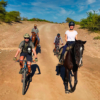Exercises For Horseback Riders
Everyone knows horseback riding is a very physical activity. Even during a relatively easy trail ride or trek, you will use your core strength, leg muscles, and balance. Naturally, the demands on your body increase if you take on more challenging rides such as our 7 day horse safaris or 10 day expedition rides. To really enjoy the wonders of Africa on horseback, it is important to be fit and flexible. While nothing beats time in the saddle, here are some great exercises for all horseback riders to help you get into the ideal equestrian shape.
Core Strength When Horseback Riding
Before getting into specific exercises, it’s good to know exactly what muscles are used when you ride a horse. Much of horseback riding uses your core muscles. These are the muscles located essentially in the center of your body. They are the muscles that you use to hold yourself upright when you sit in a chair that doesn’t have a back. When you ride a horse, you use these muscles even more to maintain your balance as the horse moves.
Think about the muscles on the front of your abdomen. These are called rectus abdominis. You will put these muscles to work to control how your lower spine curves, and the positioning of your pelvis. The muscles that are on the sides of your torso are your obliques. This is also where you will find your transversus abdominis. These muscles provide support for your spine as well. Next is your quadratus lumborum these are your lower back muscles that you’ll deploy as you shift in your seat when riding. Finally, your hip flexors provide stability in the seat as they connect your pelvis to your spine.
Of course, those are just the muscles that control your lower core. You have other muscles that help you keep your shoulders straight, support your head and neck, and keep your upper body stabilized. These include the latissimus dorsi and erector spinae. Even your gluteus maximus plays a role in helping you stay on your horse.
Other Muscles Used When Horseback Riding
As you ride, you also use your leg muscles like your quadriceps, groin and adductor muscles to hold yourself steady and to communicate with the horse by squeezing and flexing. These muscles also extend the legs allowing you to rise up in the stirrups when trotting and easily move into light seat when show jumping. The hamstrings become a key feature to keep the knees bent and the lower leg still against your horse, without unduly pressure. The gastrocnemius and the soleus are more commonly known as the calf muscles. These muscles are also engaged while riding to apply gentle pressure in transitions and stretched to keep the heels down in the stirrups.
A horse is not controlled by the arms, but by the core, seat, balance and legs. Your obliques, deltoids, latissimus dorsi are activated together to stabilize the ribcage and shoulder in a steady, neutral position. In conjunction with your triceps and biceps, they bring your elbows to a slightly bent position next to the ribcage.
What Are Some Exercises For Equestrians?
Horseback riders need a combination of strength, balance, and endurance. While nothing beats time in the saddle, there are some core exercises to build up your key muscles. If you plan on engaging in any horseback riding activity that is more intensive than you are used to, you should try these exercises a few times a week to build up your strength and stamina. These are also helpful if you find that you are more fatigued than you should be when you go on long trail rides.
Horseback Riding Exercise Precautions
As always, make sure you can exercise healthily and are wearing comfortable, appropriate gear. If you are in poor health or begin to suffer from any signs of significant pain or fatigue, stop. If it seems serious, or the pain persists, go see a doctor to ensure that you are okay. Also, get plenty of rest between exercises, drink lots of water and don’t overdo it. Always warm up with some good stretches and cool down afterwards to ensure you don’t overwork any muscles and keep yourself from the saddle. Stretching is key and helps with your flexibility – both for these exercises and for your riding.
What Leg Exercises Help With Horseback Riding?
Lunges and squats are great exercises to strengthen your leg muscles. Weak leg muscles make our leg aids ineffective and also cause us to be unbalanced in the saddle. You don’t need any special equipment, and there are variations on each to meet your needs and keep your routine interesting.
Lunges
The first exercise to try is a lunge.
- Start by standing in one place.
- Then step forward with a long step using one leg.
- Land on your heel and then roll your foot to the front.
- Once you land bend both knees so that your stationary leg almost touches the floor.
- At the same time, your upper body should be erect and facing forward.
- Slowly rise back up to a standing position and move your leg back into place.
- Repeat this several times leading off with the opposite leg each time.
You can enhance this exercise by using small hand weights and can also try walking lunges where you take a step forward as you perform each lunch.






